Display and method for manufacturing display
a technology of display and display screen, applied in the field of display, can solve the problems of large error amount between the target film thickness and the film thickness actually deposited, and is susceptible to external damage, and achieve the effects of preventing the occurrence of defective spots in the first organic electroluminescent element, and reducing the risk of damag
- Summary
- Abstract
- Description
- Claims
- Application Information
AI Technical Summary
Benefits of technology
Problems solved by technology
Method used
Image
Examples
working example
[0104]Ten blue light-emitting elements were fabricated of which micro resonator structure was designed to satisfy the first-order interference condition.
[0105]The chromaticity and light emission efficiency of the fabricated ten blue light-emitting elements were measured by using a spectral radiance meter with a constant current having a current density of 10 mA / cm2 applied to the blue light-emitting elements. Of the elements, an element from which intended light emission characteristics were obtained was defined as the design center. Furthermore, the sample with the largest film-thickness deviation in the positive direction was defined as Sample 1, while the sample with the largest film-thickness deviation in the negative direction was defined as Sample 2. The evaluation results are shown in Table 1.
TABLE 1Difference inLight EmissionLight EmissionEfficiency fromCIExCIEyEfficiency(cd / A)Design Center(%)Design0.1350.0692.611—CenterSample 10.1330.0742.8448.9Sample 20.1370.0642.322−11.1
[...
PUM
 Login to View More
Login to View More Abstract
Description
Claims
Application Information
 Login to View More
Login to View More - R&D
- Intellectual Property
- Life Sciences
- Materials
- Tech Scout
- Unparalleled Data Quality
- Higher Quality Content
- 60% Fewer Hallucinations
Browse by: Latest US Patents, China's latest patents, Technical Efficacy Thesaurus, Application Domain, Technology Topic, Popular Technical Reports.
© 2025 PatSnap. All rights reserved.Legal|Privacy policy|Modern Slavery Act Transparency Statement|Sitemap|About US| Contact US: help@patsnap.com



